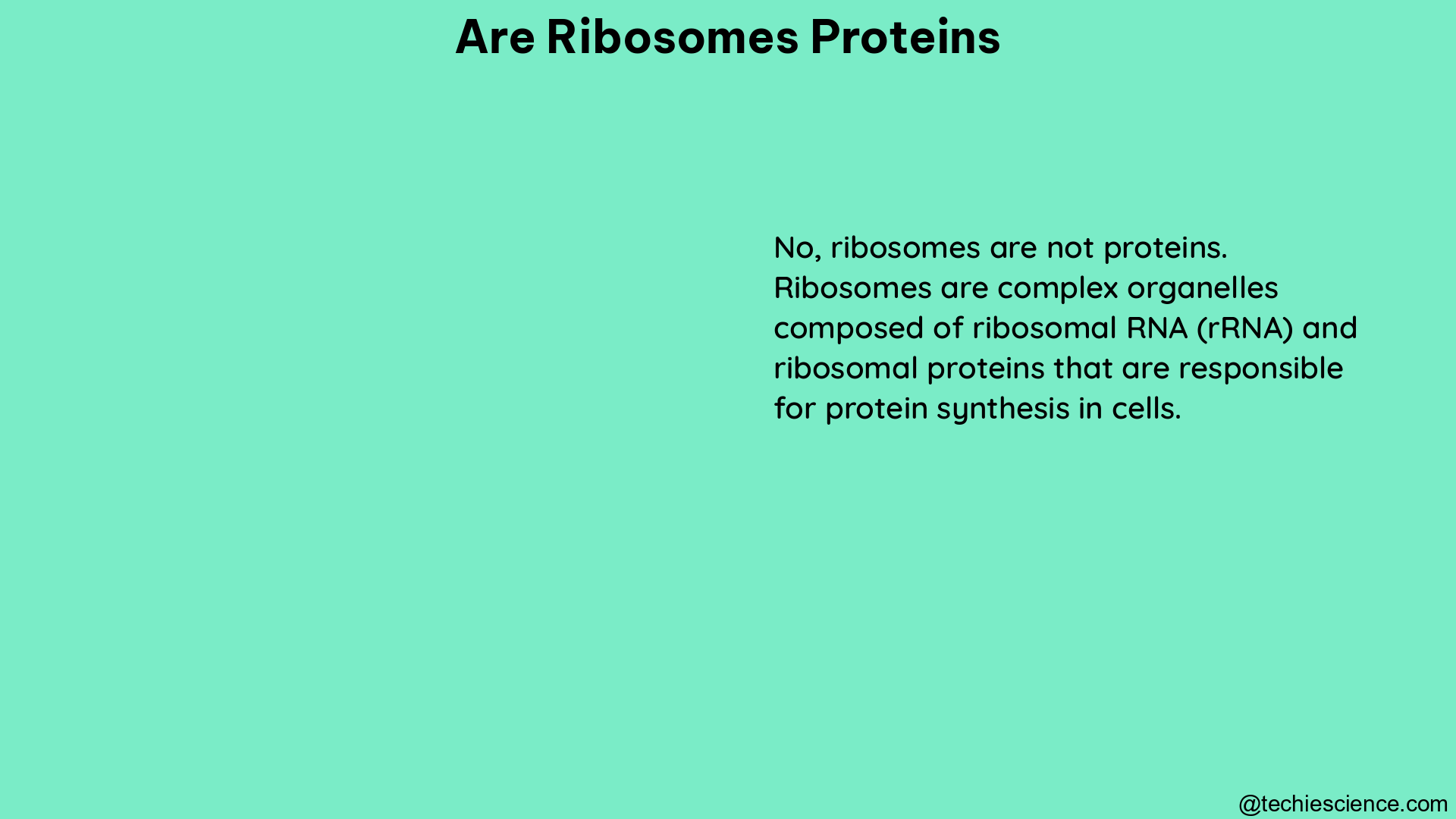Ribosomes are essential cellular organelles responsible for the synthesis of proteins, the fundamental building blocks of life. Contrary to the common misconception, ribosomes are not proteins themselves, but rather complex macromolecular structures composed of both ribonucleic acid (RNA) and proteins. Understanding the composition and function of ribosomes is crucial for comprehending the intricate mechanisms of protein synthesis and gene expression in both prokaryotic and eukaryotic cells.
The Composition of Ribosomes
Ribosomes are composed of two main subunits, the small subunit and the large subunit, which together form the complete ribosome. Each subunit is made up of a specific number of ribosomal RNA (rRNA) molecules and ribosomal proteins (r-proteins).
Prokaryotic Ribosomes
- Prokaryotic ribosomes, found in bacteria and archaea, are smaller in size and have a sedimentation coefficient of 70S.
- The small subunit (30S) contains a single 16S rRNA molecule and approximately 21 r-proteins.
- The large subunit (50S) contains two rRNA molecules (5S and 23S) and approximately 34 r-proteins.
Eukaryotic Ribosomes
- Eukaryotic ribosomes, found in the cytoplasm and organelles (such as mitochondria and chloroplasts), are larger and have a sedimentation coefficient of 80S.
- The small subunit (40S) contains a single 18S rRNA molecule and approximately 33 r-proteins.
- The large subunit (60S) contains three rRNA molecules (5S, 5.8S, and 28S) and approximately 47 r-proteins.
The rRNA molecules within the ribosomal subunits play a crucial role in the structural integrity and functional aspects of the ribosome, such as mRNA binding, tRNA positioning, and peptide bond formation. The r-proteins, on the other hand, contribute to the overall stability, assembly, and regulation of the ribosome.
The Function of Ribosomes

Ribosomes are the cellular factories responsible for the synthesis of proteins, a process known as translation. The primary function of ribosomes is to decode the genetic information stored in messenger RNA (mRNA) and use it as a template to assemble amino acids into polypeptide chains, which then fold into functional proteins.
The translation process can be divided into three main stages:
- Initiation: The small ribosomal subunit binds to the mRNA at the start codon, forming the initiation complex.
- Elongation: The large ribosomal subunit joins the initiation complex, and the ribosome moves along the mRNA, adding amino acids to the growing polypeptide chain.
- Termination: The ribosome reaches a stop codon on the mRNA, and the completed polypeptide chain is released.
During the elongation stage, the ribosome utilizes transfer RNA (tRNA) molecules, which carry specific amino acids, to assemble the polypeptide chain. The rRNA molecules within the ribosome play a crucial role in the positioning and binding of the tRNA molecules, as well as the formation of peptide bonds between the amino acids.
Ribosome Profiling: A Powerful Tool for Studying Translation
Ribosome profiling, also known as ribosome sequencing (Ribo-seq), is a powerful technique that allows researchers to study the dynamics of translation at the genome-wide level. This method involves the deep sequencing of ribosome-protected mRNA fragments, known as ribosome-protected fragments (RPFs), to obtain a snapshot of the actively translated regions of the transcriptome.
The key steps in ribosome profiling are:
- Ribosome Footprinting: Cells are treated with a translation inhibitor, such as cycloheximide, to freeze the ribosomes on the mRNA. The mRNA regions protected by the ribosomes are then digested with a nuclease, leaving behind the RPFs.
- RPF Isolation and Sequencing: The RPFs are isolated, and their sequences are determined using high-throughput sequencing technologies, such as Illumina or Ion Torrent platforms.
- Data Analysis: The sequencing data is analyzed to map the RPFs to the reference transcriptome, providing information on the positions of actively translating ribosomes and the relative abundance of translated mRNAs.
Ribosome profiling has several key applications:
- Quantification of Translation Efficiency: By comparing the abundance of RPFs to the abundance of the corresponding mRNA transcripts, researchers can calculate the translation efficiency (TE) of individual genes, revealing post-transcriptional regulation mechanisms.
- Identification of Translated Regions: Ribosome profiling can identify novel translated regions, including upstream open reading frames (uORFs), alternative start codons, and non-canonical translation events.
- Characterization of Ribosome Dynamics: The precise positioning of RPFs along the mRNA provides insights into ribosome movement, pausing, and stalling, which can be used to study translation regulation and co-translational processes.
- Linking Transcriptome to Proteome: By integrating ribosome profiling data with RNA-seq and proteomics data, researchers can gain a more comprehensive understanding of the relationship between mRNA abundance, translation, and protein levels.
Regulation of Ribosome Biogenesis and Abundance
Ribosome biogenesis and abundance are tightly regulated processes that are crucial for cellular homeostasis and adaptation to various environmental and physiological conditions.
Regulation of Ribosome Biogenesis
- Ribosome biogenesis is a complex, multi-step process that involves the transcription of rRNA genes, the assembly of ribosomal subunits, and the transport of these subunits to the cytoplasm.
- This process is regulated by various transcription factors, signaling pathways, and epigenetic mechanisms, which ensure the coordinated expression of the genes encoding rRNAs and r-proteins.
- Disruptions in ribosome biogenesis can lead to a condition known as ribosomopathy, which is associated with various human diseases, including cancer, neurological disorders, and congenital syndromes.
Regulation of Ribosome Abundance
- Cells can adjust the abundance of ribosomes in response to changes in nutrient availability, growth conditions, and cellular stress.
- During nutrient starvation or stress, cells can rapidly downregulate ribosome abundance to conserve energy and resources, a process known as “ribosome hibernation.”
- Conversely, rapidly growing or proliferating cells, such as cancer cells, often exhibit increased ribosome abundance to support their high protein synthesis demands.
- The regulation of ribosome abundance involves the modulation of r-protein synthesis, ribosomal subunit assembly, and the selective degradation of ribosomes through processes like autophagy.
Understanding the complex mechanisms that govern ribosome biogenesis and abundance is crucial for elucidating the role of ribosomes in cellular homeostasis, disease pathogenesis, and therapeutic interventions.
Conclusion
In summary, ribosomes are not proteins, but rather complex macromolecular structures composed of both RNA and proteins. Ribosomes play a central role in the process of protein synthesis, decoding the genetic information stored in mRNA and assembling amino acids into functional polypeptide chains. The composition and function of ribosomes are tightly regulated to ensure cellular homeostasis and adaptation to various environmental and physiological conditions. Techniques like ribosome profiling have provided valuable insights into the dynamics of translation and the relationship between the transcriptome, translatome, and proteome. Continued research on ribosomes and their regulation will undoubtedly lead to a deeper understanding of the fundamental mechanisms of life and the development of novel therapeutic strategies.
References
- Biomarker Research. (2024). Ribosome profiling: A powerful tool for quantitative analysis of translation dynamics. https://biomarkerres.biomedcentral.com/articles/10.1186/s40364-024-00562-4
- NCBI. (2021). Ribosome profiling: a powerful tool for deciphering the translational landscape. https://www.ncbi.nlm.nih.gov/pmc/articles/PMC8274658/
- Nature Scitable. (n.d.). Ribosomes, Transcription, and Translation. https://www.nature.com/scitable/topicpage/ribosomes-transcription-and-translation-14120660/
- University of Manchester. (n.d.). Ribosome profiling: a powerful tool for studying translation. https://research.manchester.ac.uk/files/54535242/FULL_TEXT.PDF
- NCBI. (2020). Ribosome profiling: a powerful tool for the discovery of novel regulatory mechanisms. https://www.ncbi.nlm.nih.gov/pmc/articles/PMC7351614/

I am a doctoral student of CSIR- CIMAP, Lucknow. I am devoted to the field of plant metabolomics and environmental science. I have completed my post-graduation from the University of Calcutta with expertise in Molecular Plant Biology and Nanotechnology. I am an ardent reader and incessantly developing concepts in every niche of biological sciences. I have published research articles in peer-reviewed journals of Elsevier and Springer. Apart from academic interests, I am also passionate about creative things such as photography and learning new languages.
Let’s connect over Linkedin